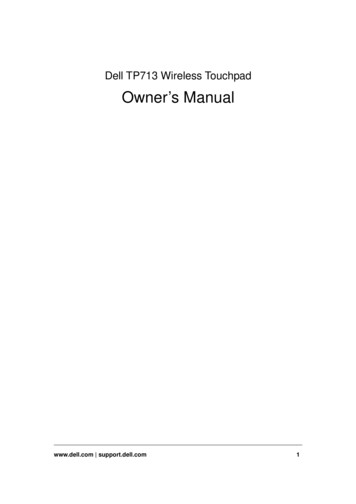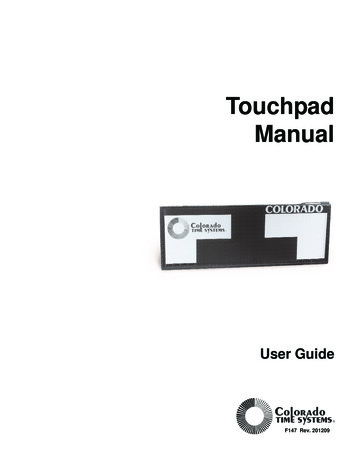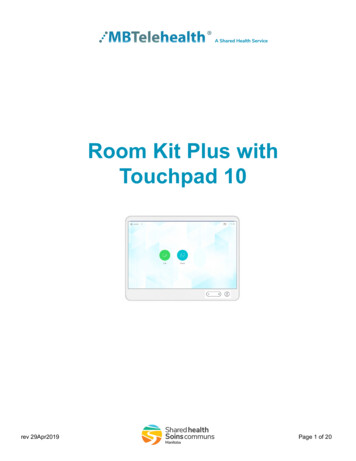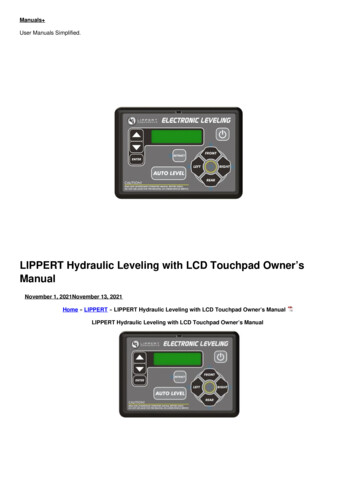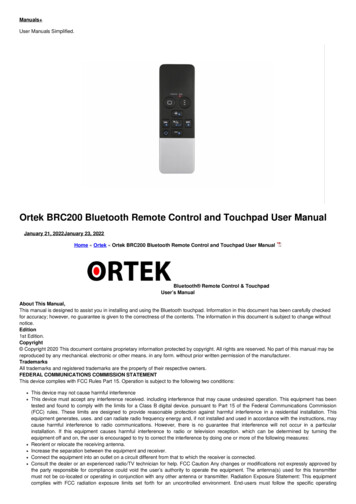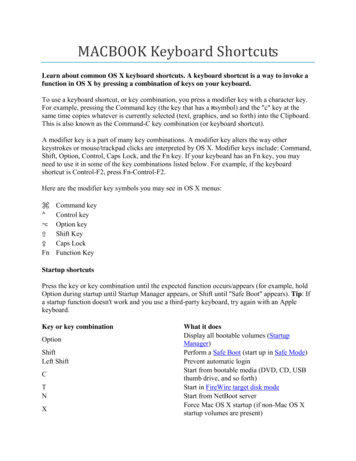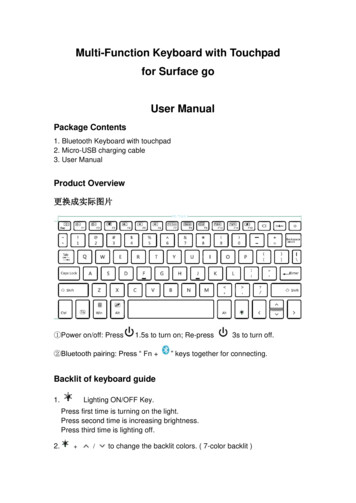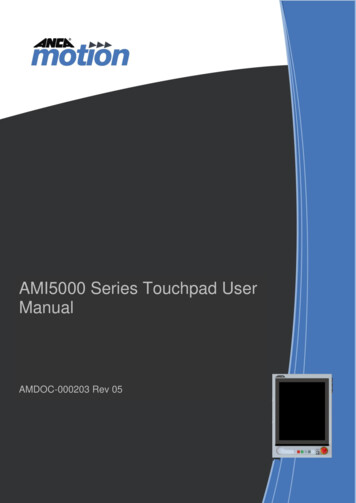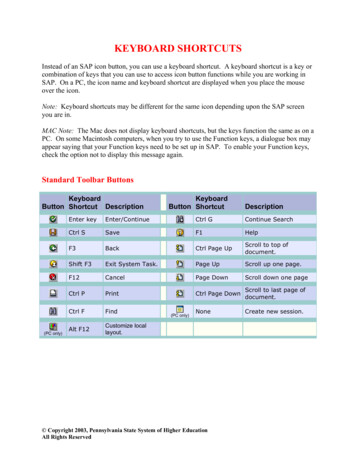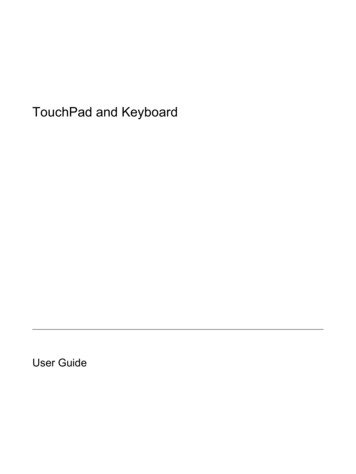
Transcription
TouchPad and KeyboardUser Guide
Copyright 2007 Hewlett-PackardDevelopment Company, L.P.Windows is a U.S. registered trademark ofMicrosoft Corporation.The information contained herein is subjectto change without notice. The onlywarranties for HP products and services areset forth in the express warranty statementsaccompanying such products and services.Nothing herein should be construed asconstituting an additional warranty. HP shallnot be liable for technical or editorial errorsor omissions contained herein.First Edition: April 2007Document Part Number: 438898-001
Product noticeThis user guide describes features that are common to most models. Some features may not beavailable on your computer.ENWWiii
ivProduct noticeENWW
Table of contents1 Using the TouchPadUsing the TouchPad . 1Setting TouchPad preferences . 2Connecting an external mouse . 22 Using the keyboardUsing hotkeys . 3Displaying system information (fn esc) . 4Opening Help and Support (fn f1) . 4Opening the Print Options window (fn f2) . 4Opening a Web browser (fn f3) . 5Switching the screen image (fn f4) . 5Initiating Hibernation (fn f5) . 6Initiating QuickLock (fn f6) . 6Decreasing screen brightness (fn f7) . 6Increasing screen brightness (fn f8) . 6Playing, pausing or resuming an audio CD or a DVD (fn f9) . 6Stopping an audio CD or a DVD (fn f10) . 6Playing previous track or section of an audio CD or a DVD (fn f11) . 7Playing next track or section of an audio CD or a DVD (fn f12) . 73 Using the keypadsUsing an optional external numeric keypad . 84 Cleaning the TouchPad and keyboardIndex . 11ENWWv
viENWW
1Using the TouchPadUsing the TouchPadThe following illustration and table describe the computer TouchPad.ComponentDescription(1) Blue: TouchPad is enabled. Amber: TouchPad is disabled.TouchPad light(2)TouchPad*Moves the pointer and selects or activates items on the screen.(3)Left TouchPad button*Functions like the left button on an external mouse.(4)Right TouchPad button*Functions like the right button on an external mouse.(5)TouchPad scroll zone*Scrolls up or down.(6)TouchPad on/off buttonEnables/disables the TouchPad.*This table describes factory settings. To view and change pointing device preferences, select Start Control Panel Hardware and Sound Mouse.To move the pointer, slide your finger across the TouchPad surface in the direction you want the pointerto go. Use the TouchPad buttons as you would the corresponding buttons on an external mouse. Toscroll up and down using the TouchPad vertical scroll zone, slide your finger up or down over the lines.ENWWUsing the TouchPad1
NOTE: If you are using the TouchPad to move the pointer, you must lift your finger off theTouchPad before moving it to the scroll zone. Simply sliding your finger from the TouchPad tothe scroll zone will not activate the scrolling function.Setting TouchPad preferencesTo access Mouse Properties, select Start Control Panel Hardware and Sound Mouse.Use Mouse Properties in Windows to customize settings for pointing devices, such as buttonconfiguration, click speed, and pointer options.Connecting an external mouseYou can connect an external USB mouse to the computer using one of the USB ports on the computer.A USB mouse can also be connected to the system by using the ports on an optional docking deviceor optional expansion product.2Chapter 1 Using the TouchPadENWW
2Using the keyboardUsing hotkeysHotkeys are combinations of the fn key (1) and either the esc key (2) or one of the function keys (3).The icons on the f1 through f12 keys represent the hotkey functions. Hotkey functions and proceduresare discussed in the following sections.ENWWFunctionHotkeyDisplay system information.fn escOpen Help and Support.fn f1Open the Print Options window.fn f2Open a Web browser.fn f3Alternate between computer display and externaldisplay.fn f4Initiate Hibernation.fn f5Initiate QuickLock.fn f6Decrease screen brightness.fn f7Increase screen brightness.fn f8Play, pause, or resume an audio CD or a DVD.fn f9Using hotkeys3
FunctionHotkeyStop an audio CD or a DVD.fn f10Play the previous track or section on an audio CD ora DVD.fn f11Play the next track on an audio CD or a DVD.fn f12To use a hotkey command on the computer keyboard, follow either of these steps: Briefly press the fn key, and then briefly press the second key of the hotkey command.– or – Press and hold down the fn key, briefly press the second key of the hotkey command, and thenrelease both keys at the same time.Displaying system information (fn esc)Press fn esc to display information about system hardware components and the system BIOS versionnumber.In the Windows fn esc display, the version of the system BIOS (basic input-output system) is displayedas the BIOS date. On some computer models, the BIOS date is displayed in decimal format. The BIOSdate is sometimes called the system ROM version number.Opening Help and Support (fn f1)Press fn f1 to open Help and Support.In addition to providing information about your Windows operating system, Help and Support providesthe following information and tools: Information about your computer, such as model and serial number, installed software, hardwarecomponents, and specifications Answers to questions about using your computer Tutorials to help you learn to use the computer and Windows features Updates for the Windows operating system, drivers, and the software provided on your computer Checkups for computer functionality Automated and interactive troubleshooting, repair solutions, and system recovery procedures Links to support specialistsOpening the Print Options window (fn f2)Press fn f2 to open the Print Options window of the active Windows application.4Chapter 2 Using the keyboardENWW
Opening a Web browser (fn f3)Press fn f3 to open your Web browser.Until you have set up your Internet or network services, the fn f3 hotkey opens the Windows InternetConnection Wizard.After you have set up your Internet or network services and your Web browser home page, you canpress fn f3 to quickly access your home page and the Internet.Switching the screen image (fn f4)Press fn f4 to switch the screen image among display devices connected to the system. For example,if a monitor is connected to the computer, pressing fn f4 alternates the screen image from computerdisplay to monitor display to simultaneous display on both the computer and the monitor.Most external monitors receive video information from the computer using the external VGA videostandard. The fn f4 hotkey can also alternate images among other devices receiving video informationfrom the computer.The following video transmission types, with examples of devices that use them, are supported bythe fn f4 hotkey: LCD (computer display) External VGA (most external monitors) S-Video (televisions, camcorders, VCRs, and video capture cards with S-Video-in jacks) Composite video (televisions, camcorders, VCRs, and video capture cards with composite-videoin jacks)NOTE: Composite video devices can be connected to the system only by using an optionaldocking device or an optional expansion product.ENWWUsing hotkeys5
Initiating Hibernation (fn f5)CAUTION: To reduce the risk of information loss, save your work before initiating Hibernation.Press fn f5 to initiate Hibernation.When Hibernation is initiated, your information is saved to a hibernation file on the hard drive and thecomputer turns off.The computer must be on before you can initiate Hibernation.To exit Hibernation, briefly press the power button.The function of the fn f5 hotkey can be changed. For example, you can set the fn f5 hotkey to initiateSleep instead of Hibernation.Initiating QuickLock (fn f6)Press fn f6 to initiate the QuickLock security feature.QuickLock protects your information by displaying the operating system Log On window. While the LogOn window is displayed, the computer cannot be accessed until a Windows user password or a Windowsadministrator password is entered.NOTE: Before you can use QuickLock, you must set a Windows user password or a Windowsadministrator password. For instructions, refer to Help and Support.To use QuickLock, press fn f6 to display the Log On window and lock the computer. Then follow theinstructions on the screen to enter your Windows user password or your Windows administratorpassword and access the computer.Decreasing screen brightness (fn f7)Press fn f7 to decrease screen brightness. Hold down the hotkey to decrease the brightness levelincrementally.Increasing screen brightness (fn f8)Press fn f8 to increase screen brightness. Hold down the hotkey to increase the brightness levelincrementally.Playing, pausing or resuming an audio CD or a DVD (fn f9)The fn f9 hotkey functions only when an audio CD or a DVD is inserted: If the audio CD or the DVD is not playing, press fn f9 to begin or resume the play. If the audio CD or the DVD is playing, press fn f9 to pause the play.Stopping an audio CD or a DVD (fn f10)Press fn f10 to stop the play of an audio CD or a DVD.6Chapter 2 Using the keyboardENWW
Playing previous track or section of an audio CD or a DVD (fn f11)While an audio CD or a DVD is playing, press fn f11 to play the previous track of the CD or the previoussection of the DVD.Playing next track or section of an audio CD or a DVD (fn f12)While an audio CD or a DVD is playing, press fn f12 to play the next track of the CD or the next sectionof the DVD.ENWWUsing hotkeys7
3Using the keypadsThe computer has an integrated numeric keypad and also supports an optional external numeric keypador an optional external keyboard that includes a numeric keypad.ComponentDescription(1)fn keyExecutes frequently used system functions when pressed incombination with a function key or the esc key.(2)num lk keyPress to enable the integrated numeric keypad.(3)Num lock lightOn: Num lock is on.(4)Integrated numeric keypadCan be used like the keys on an external numeric keypad.Using an optional external numeric keypadKeys on most external numeric keypads function differently according to whether num lock mode is onor off. (Num lock is turned off at the factory.) For example: When num lock is on, most keypad keys type numbers. When num lock is off, most keypad keys function like the arrow, page up, or page down keys.When num lock on an external keypad is turned on, the num lock light on the computer is turned on.When num lock on an external keypad is turned off, the num lock light on the computer is turned off.8Chapter 3 Using the keypadsENWW
To turn num lock on or off on an external keypad as you work: ENWWPress the num lock key on the external keypad, not on the computer.Using an optional external numeric keypad9
4Cleaning the TouchPad and keyboardDirt and grease on the TouchPad can cause the pointer to jump around on the screen. To avoid this,clean the TouchPad with a damp cloth, and wash your hands frequently when using the computer.WARNING! To reduce the risk of electric shock or damage to internal components, do not usea vacuum cleaner attachment to clean the keyboard. A vacuum cleaner could deposit householddebris on the keyboard surface.Clean the keyboard regularly to prevent keys from sticking and to remove dust, lint, and particles thatcan become trapped beneath the keys. A can of compressed air with a straw extension can be used toblow air around and under the keys to loosen and remove debris.10Chapter 4 Cleaning the TouchPad and keyboardENWW
IndexBbuttonsTouchPad 1TouchPad on/off 1Ccomposite video 5Ddisplayimage, switching 5screen brightness hotkeys 6Ffn key 3function keys 3HHelp and Support hotkey 4Hibernation hotkey 6hotkeysaudio CD or DVD controls 6decreasing screenbrightness 6description 3displaying systeminformation 4increasing screenbrightness 6initiating Hibernation 6initiating QuickLock 6opening Help and Support 4opening Print Optionswindow 4opening Web browser 5switching screen image 5using 4ENWWKkeyboardcleaning 10using 3keyboard hotkeys, identifying 3keypad, integrated, identifying 8Llightsnum lock 8TouchPad 1setting preferences 2using 1TouchPad light, identifying 1TouchPad on/off button 1Vvideo transmission types 5WWeb browser hotkey 5Mmedia controls, hotkeys 6mouse, externalconnecting 2setting preferences 2Nnum lock light, identifying 8PPrint Options window hotkey 4QQuickLock hotkey 6SS-Video 5screen brightness hotkeys 6screen image, switching 5scrolling regions, TouchPad 1system information hotkey 4TTouchPadbuttons 1cleaning 10identifying 1scrolling regions 1Index11
Using the TouchPad The following illustration and table describe the computer TouchPad. Component Description (1) TouchPad light Blue: TouchPad is enabled. Amber: TouchPad is disabled. (2) TouchPad* Moves the pointer and selects or activates items on the screen. (3) Left TouchPad button* Functions like the left button on an external mouse.

